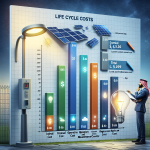Sustainable Disposal and Recycling of Solar Street Light Components
Table of Contents
Sustainable disposal and recycling of solar street light components are critical aspects of environmental stewardship and resource management in the renewable energy sector. As solar street lighting systems become increasingly prevalent due to their energy efficiency and eco-friendly benefits, addressing the end-of-life phase of these systems is essential to minimize environmental impact. Solar street lights typically comprise photovoltaic panels, batteries, LED lamps, and various electronic components, each requiring specific disposal and recycling methods to prevent hazardous waste and promote resource recovery. Implementing sustainable practices involves developing efficient recycling processes for materials like silicon, glass, metals, and plastics, as well as ensuring the safe handling of potentially toxic substances found in batteries and electronic parts. By fostering a circular economy approach, where materials are reused and recycled, the solar industry can significantly reduce its carbon footprint, conserve natural resources, and contribute to a more sustainable future.
Innovations In Recycling Solar Panel Materials For Street Lights
The increasing adoption of solar street lights as a sustainable alternative to traditional lighting systems has brought about a significant shift in urban and rural infrastructure. As these systems become more prevalent, the need for sustainable disposal and recycling of their components has become a pressing concern. Solar street lights are composed of several key components, including solar panels, batteries, light-emitting diodes (LEDs), and various electronic parts. Each of these components presents unique challenges and opportunities for recycling and disposal, necessitating innovative approaches to ensure environmental sustainability.
Solar panels, the most visible component of solar street lights, are primarily made of silicon, glass, and aluminum. While these materials are generally recyclable, the process of recycling solar panels is complex and requires specialized facilities. Recent innovations in recycling technology have focused on improving the efficiency of material recovery from solar panels. For instance, advanced mechanical and chemical processes have been developed to separate and purify silicon, allowing it to be reused in the production of new solar cells. Additionally, the recovery of aluminum and glass from solar panels has been streamlined, reducing the energy consumption and environmental impact of the recycling process.
Transitioning to the batteries used in solar street lights, these components often contain hazardous materials such as lead or lithium, which pose significant environmental risks if not disposed of properly. Innovations in battery recycling have been crucial in mitigating these risks. For lead-acid batteries, which are commonly used in older solar street light systems, recycling processes have been well-established, allowing for the recovery of lead and other materials. However, the shift towards lithium-ion batteries in newer systems has necessitated the development of new recycling techniques. Recent advancements have focused on the safe extraction of lithium, cobalt, and other valuable metals from spent batteries, thereby reducing the need for virgin material extraction and minimizing environmental harm.
Moreover, the LEDs used in solar street lights are another component that requires careful consideration in terms of disposal and recycling. LEDs contain small amounts of valuable metals such as gallium and indium, which can be recovered and reused. Innovations in LED recycling have centered on the development of processes that efficiently separate these metals from other materials, ensuring that they can be reintegrated into the production cycle. This not only conserves resources but also reduces the environmental footprint associated with LED manufacturing.
In addition to these component-specific innovations, there is a growing emphasis on designing solar street lights with end-of-life considerations in mind. This approach, known as design for disassembly, involves creating products that are easier to take apart and recycle. By incorporating modular designs and using materials that are more readily recyclable, manufacturers can facilitate the recycling process and enhance the sustainability of solar street lights.
In conclusion, the sustainable disposal and recycling of solar street light components are critical to the long-term viability of this technology. Through innovations in recycling processes and a focus on design for disassembly, the environmental impact of solar street lights can be significantly reduced. As the adoption of solar street lighting continues to grow, these advancements will play a vital role in ensuring that this sustainable technology remains environmentally friendly throughout its lifecycle.
Sustainable Disposal Methods For Solar Street Light Batteries

The increasing adoption of solar street lights as a sustainable alternative to traditional lighting systems has brought about significant environmental benefits. However, as these systems reach the end of their life cycle, the challenge of disposing of their components, particularly batteries, in an environmentally responsible manner becomes paramount. Solar street lights typically use rechargeable batteries, such as lithium-ion or lead-acid, to store energy. These batteries, while efficient, pose potential environmental hazards if not disposed of properly. Therefore, understanding sustainable disposal methods for these batteries is crucial in minimizing their ecological impact.
To begin with, it is essential to recognize the potential environmental risks associated with improper disposal of solar street light batteries. These batteries contain hazardous materials, including heavy metals and toxic chemicals, which can leach into the soil and water, causing pollution and posing health risks to humans and wildlife. Consequently, the first step in sustainable disposal is to prevent these materials from entering the environment. This can be achieved through recycling, which not only mitigates environmental harm but also recovers valuable materials that can be reused in the production of new batteries.
Recycling processes for solar street light batteries vary depending on the type of battery. For instance, lithium-ion batteries, commonly used in modern solar street lights, can be recycled through a process that involves disassembling the battery to recover lithium, cobalt, nickel, and other metals. These materials can then be refined and used in the manufacture of new batteries, thus closing the loop in the battery life cycle. On the other hand, lead-acid batteries, which are often found in older solar street light systems, are among the most recycled battery types. The recycling process for lead-acid batteries involves breaking down the battery into its components, recovering lead and plastic, and neutralizing the acid for safe disposal or reuse.
In addition to recycling, another sustainable disposal method is the refurbishment and repurposing of batteries. Batteries that have not reached the end of their useful life can be refurbished and used in less demanding applications, thereby extending their life span and reducing waste. This approach not only conserves resources but also provides a cost-effective solution for communities and organizations looking to implement sustainable practices.
Furthermore, the role of legislation and policy cannot be overlooked in promoting sustainable disposal methods for solar street light batteries. Governments and regulatory bodies play a critical role in establishing guidelines and standards for battery disposal and recycling. By enforcing regulations that mandate the proper handling and recycling of batteries, authorities can ensure that these practices are widely adopted and adhered to. Additionally, incentives and support for research and development in battery recycling technologies can further enhance the efficiency and effectiveness of these processes.
Public awareness and education are also vital components in the sustainable disposal of solar street light batteries. By informing communities and stakeholders about the importance of proper battery disposal and the available recycling options, individuals and organizations can be encouraged to participate actively in these efforts. Educational campaigns and initiatives can help foster a culture of environmental responsibility and sustainability.
In conclusion, the sustainable disposal and recycling of solar street light batteries are essential in mitigating their environmental impact and promoting a circular economy. Through recycling, refurbishment, supportive legislation, and public awareness, the challenges associated with battery disposal can be effectively addressed. As the adoption of solar street lights continues to grow, it is imperative that these sustainable practices are prioritized to ensure that the environmental benefits of solar technology are fully realized.
Eco-Friendly Practices For Recycling Solar Street Light Poles And Fixtures
As the world increasingly embraces renewable energy solutions, solar street lights have emerged as a popular choice for sustainable urban and rural lighting. These systems, which harness solar energy to illuminate streets, pathways, and public spaces, offer numerous environmental benefits, including reduced carbon emissions and decreased reliance on fossil fuels. However, as with any technology, solar street lights have a finite lifespan, necessitating thoughtful consideration of their disposal and recycling. The sustainable disposal and recycling of solar street light components are crucial to minimizing environmental impact and promoting a circular economy.
To begin with, the primary components of solar street lights include solar panels, batteries, light fixtures, and poles. Each of these elements presents unique challenges and opportunities for recycling. Solar panels, typically composed of silicon, glass, and metal, can be recycled to recover valuable materials. Specialized recycling facilities can extract silicon and other metals, which can then be reused in the production of new solar panels or other electronic devices. This process not only conserves resources but also reduces the need for raw material extraction, which can be environmentally damaging.
In addition to solar panels, the batteries used in solar street lights require careful handling. Most systems utilize either lead-acid or lithium-ion batteries, both of which contain hazardous materials that can pose environmental risks if not disposed of properly. Lead-acid batteries are widely recycled, with established processes for recovering lead and other components. Recycling lithium-ion batteries, while more complex, is gaining traction as technology advances. By ensuring that batteries are recycled through certified programs, municipalities and organizations can prevent harmful substances from leaching into the environment and contribute to the sustainable lifecycle of solar street lights.
Moreover, the light fixtures and poles of solar street lights also offer opportunities for recycling and repurposing. Light fixtures, often made from aluminum or other metals, can be melted down and reused in various industries. Similarly, the poles, typically constructed from steel or aluminum, can be recycled or repurposed for other infrastructure projects. By adopting these practices, communities can reduce waste and promote the efficient use of materials.
Transitioning to sustainable disposal and recycling practices for solar street light components requires collaboration among manufacturers, municipalities, and recycling facilities. Manufacturers can play a pivotal role by designing products with end-of-life considerations in mind, such as using easily recyclable materials and providing clear guidelines for disassembly and recycling. Municipalities, on the other hand, can implement policies and programs that encourage the collection and recycling of solar street light components, ensuring that they are directed to appropriate facilities.
Furthermore, public awareness and education are essential in promoting eco-friendly practices. By informing communities about the importance of recycling solar street light components and providing accessible recycling options, stakeholders can foster a culture of sustainability. This not only benefits the environment but also supports the development of green industries and job creation.
In conclusion, the sustainable disposal and recycling of solar street light components are integral to maximizing the environmental benefits of this renewable energy technology. Through collaborative efforts and a commitment to eco-friendly practices, it is possible to minimize waste, conserve resources, and contribute to a more sustainable future. As the adoption of solar street lights continues to grow, so too must our dedication to responsible end-of-life management, ensuring that these systems remain a beacon of sustainability for generations to come.
Read more about Solar Street Lighting:









